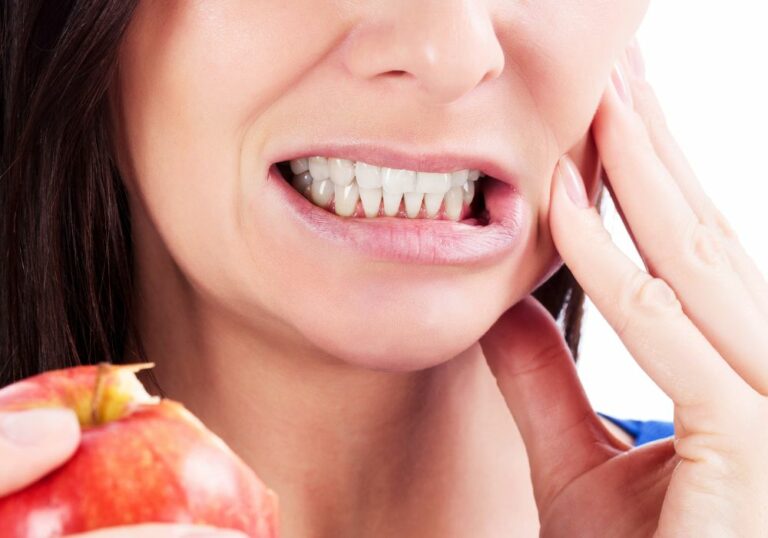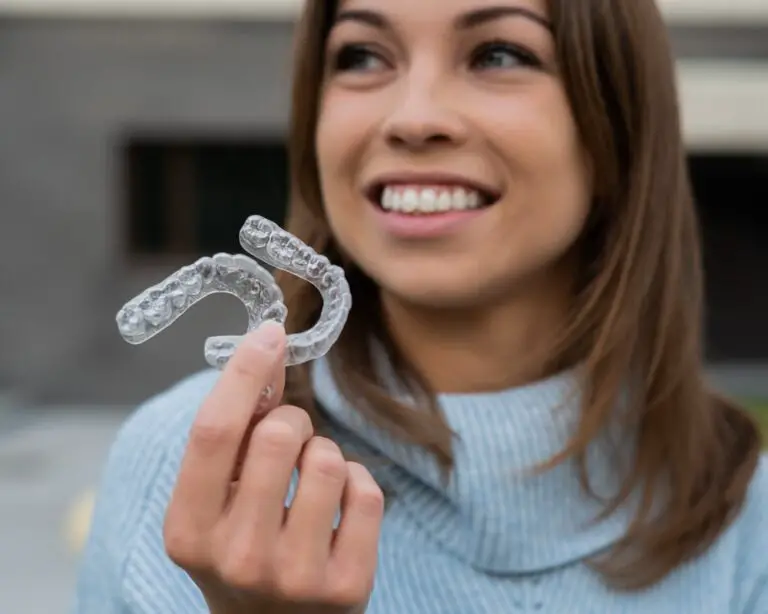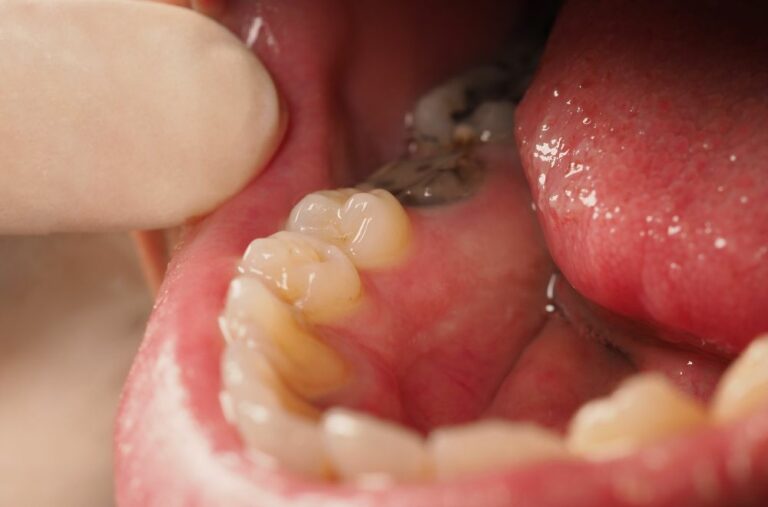Smoking is one of the worst habits for oral health. The smoke from cigarettes and other tobacco products can stain teeth, cause gum disease, and increase the risk of oral cancer. Many smokers notice their teeth turning yellow or brown over time. But what happens if you quit? Can teeth recover from years of smoking damage?
How smoking damages teeth and oral health
Smoking negatively impacts teeth and gums in a few key ways:
Tobacco stains
Tobacco smoke contains thousands of chemicals, including tar and nicotine. These substances can stick to tooth enamel when inhaled or absorbed directly from cigarettes held in the mouth. Nicotine and tar uptake causes brown or yellow stains that build up over time.
The stains often first appear at the gumline and between teeth, which have slightly porous surfaces for compounds to penetrate. Stains then spread toward the biting edges of teeth. The stains can appear on both natural teeth and dental work like fillings, crowns, and veneers. Smoking just a few cigarettes per day can cause noticeable stains within a couple of years.
With continued tobacco use, the stains darken and spread, covering more tooth surfaces. After many years of heavy smoking, teeth can become brown, dark yellow, or even blackened.
Plaque buildup
Smoking impairs your mouth’s natural cleaning processes in a few ways:
- The chemicals in tobacco smoke reduce saliva flow in the mouth and throat. Having less saliva allows more bacteria and plaque to accumulate on teeth. Saliva contains minerals that strengthen enamel and help balance mouth pH. Lower saliva also means less rinsing of food debris from the teeth.
- Smoke irritates gum tissue, causing inflammation and bleeding. Irritated gums don’t attach as tightly to teeth, allowing more plaque to build up under the gumline.
- Cigarette smoke blocks antibodies and white blood cells in saliva that kill bacteria. Immune function in the mouth becomes impaired.
With high amounts of plaque building up and less bacterial control, tooth and gum surfaces are constantly exposed to acids and toxins produced by plaque.
Gum disease
The plaque buildup leads to gingivitis – inflammation and bleeding of the gums. Gums turn red or purplish, especially near the base of teeth. They become tender and bleed when brushing or flossing.
Gingivitis often progresses to periodontitis gum disease, where plaque spreads below the gumline. Chronic inflammation causes gums to slowly pull away from teeth. Tiny pockets form which allow more bacteria to accumulate and some teeth to loosen.
Studies clearly show smokers have a significantly higher risk of all types and severities of gum disease:
- Smokers are up to 6 times more likely to have gingivitis than nonsmokers.
- Moderate to severe bone loss from periodontitis is 2-3 times more common in smokers.
- Heavy smokers have over 4 times the risk of losing teeth versus nonsmokers.
Gum disease also gets more severe at a younger age and faster rate in smokers.
Tooth decay
The dry mouth and excess plaque caused by smoking also dramatically promote tooth decay. Plaque bacteria produce acids that erode tooth enamel. Saliva normally helps neutralize these acids and repair early erosion. But when saliva volume is low, acid attacks teeth longer, more often, and more severely before being washed away.
This prolonged acid exposure leads to more cavities – both around the gumline and between teeth. Tooth decay may progress rapidly and cause sensitivity, pain, or even nerve damage requiring a root canal.
Studies show the prevalence and severity of tooth decay is 2-4 times higher in smokers compared to nonsmokers.
Oral cancer
Tobacco use, including smokeless tobacco and e-cigarettes, raises the risk of cancers of the mouth, lips, tongue, and throat. The many carcinogens in tobacco damage DNA and cause genetic mutations that lead to cancerous tumor growth.
The longer you smoke and more cigarettes smoked per day, the higher the oral cancer risk. Oral cancer risks remain higher for decades after quitting smoking compared to never smokers.
Unfortunately, oral cancer is often not diagnosed until an advanced stage when the tumor is large or has spread. Surgery is needed to remove cancerous sections of the mouth, tongue, or throat. This can mean extracting teeth or part of the jawbone if the cancer has grown around the teeth and gums.
Can stained teeth return to normal color?
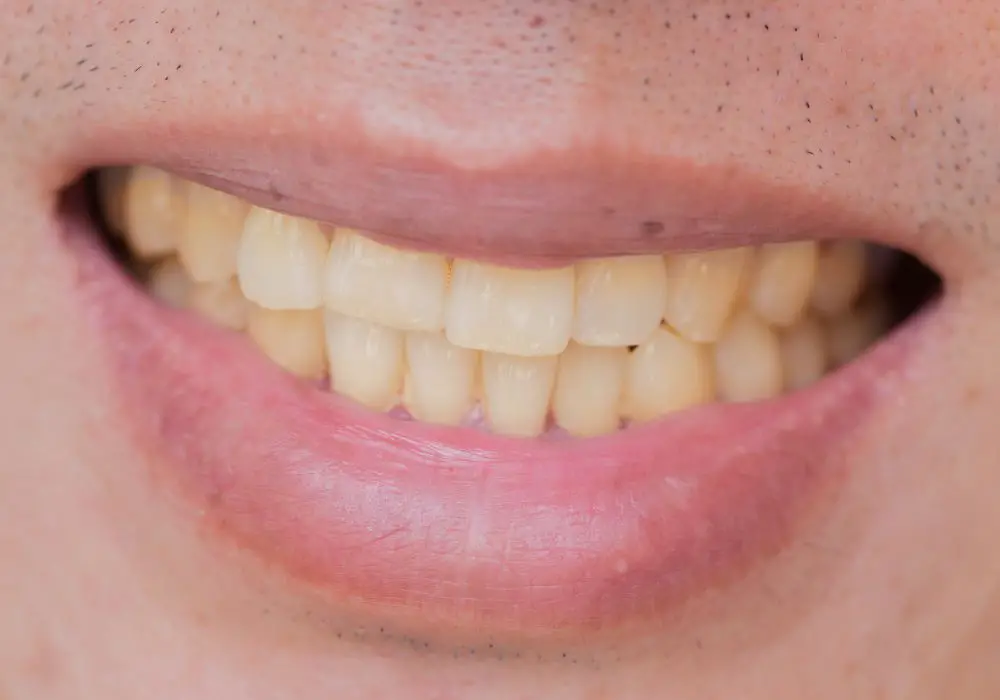
The accumulated tar and nicotine in tobacco smoke leads to stubborn brown and yellow stains that make teeth appear darker and more yellow. Will these smoking stains disappear if you stop smoking?
Unfortunately, smoking stains on natural teeth enamel are permanent. Enamel is the tough outer layer of the tooth. It does not contain any living cells and cannot regenerate or repair itself once damaged.
When tobacco byproducts penetrate and bond with enamel, the stains become incorporated into the enamel structure. There are currently no procedures or products proven to reverse or remove deep intrinsic stains within enamel.
However, there are a few ways to improve the appearance of stained natural teeth:
Professional teeth whitening uses custom-fitted trays or in-office treatments with powerful peroxide gels to penetrate enamel and lighten staining. Peroxide breaks up large tobacco stain molecules into smaller fragments that reflect less color. Good results are possible, but very dark or long-term staining often can’t be completely removed.
Dental bonding applies tooth-colored resin material to the front of teeth. This masks intrinsic stains and reshapes teeth for a more uniform color. However, bonding stains again over time if you continue to smoke.
Porcelain veneers are thin ceramic shells bonded over the front of teeth. They fully cover dark stains to create a whiter, brighter smile.
Dental crowns cap entire teeth with customized porcelain. They provide the most complete coverage and longest-lasting result for severely stained teeth. But crowning healthy teeth just for cosmetics requires removing additional natural tooth structure.
Professional cosmetic dentistry treatments like these require an investment of time and money. But they can dramatically brighten your smile and mask deep smoking stains. For example, custom-fitted whitening trays with 15% carbamide peroxide used daily for 2 weeks can lighten deep intrinsic smoking stains by up to 4-6 shades on the dental shade guide.
While stains on natural enamel won’t go away on their own, stains on dental work like composite fillings, cement, and acrylic dentures can fade over time if you quit smoking. The accumulating tar eventually penetrates these restoration materials because they are porous. As the surface material accumulates more stains, the dental work darkens and appears more yellow.
If you stop smoking, these dental restorations should regain their original color in 4-8 weeks as the superficial surface stains gradually wear away or are brushed off to reveal cleaner material underneath. However, deeper intrinsic stains may remain. Replacing restorations may be needed for more significant staining.
Do gums heal after quitting smoking?

Gum disease is one of the most severe oral health risks of regular tobacco use. Can gum tissue recover and regain health after the daily assault of smoking stops?
Fortunately, gums have a strong natural ability to heal themselves when the causes of inflammation and damage are removed. Within just 1-2 weeks after quitting smoking, most people begin to notice improvements with gum appearance and symptoms.
Healing timeline after quitting:
- 1-2 weeks – Blood flow improves as arteries and vessels relax and inflammation decreases. Gums look less red, purplish, and swollen as the toxins in cigarette smoke stop impacting the gingiva multiple times per day.
- 1-3 months – Gums regain a natural light pink color. Continued healing of damaged blood vessels reduces swelling and bleeding. Less plaque buildup means less bacterial irritation. At this point, your dentist will likely notice early stages of gingivitis starting to resolve.
- 6-12 months – Most former smokers have significantly decreased gum bleeding, sensitivity, and soreness. Pockets around teeth begin to shrink and fill in as gums reattach more firmly to tooth surfaces after being inflamed and detached. Your periodontal risk profile improves.
- 1-2 years – With sustained excellent oral hygiene, the gumline can reattach very closely to the teeth again. Gum “pockets” may shrink to the point of returning to full health. This greatly reduces areas for bacteria to grow and protects remaining teeth long-term.
Full recovery for advanced gum disease
For those with more severe, untreated gum disease already present from smoking, full recovery is harder to achieve and takes longer. Gum tissue destroyed by periodontitis cannot grow back. Lost bone around teeth is also permanent in most cases.
However, quitting smoking coupled with professional deep cleanings, antibiotics, and diligent daily plaque removal allows stabilization of gum disease so it doesn’t rapidly get worse. Healthy pockets and gum attachments can be maintained long-term.
People with extreme bone loss may also benefit from gum grafting or regenerative periodontal procedures to stimulate some new bone growth. Though expensive and involved, these treatments can sometimes help avoid tooth extractions.
Within 5-10 years after stopping smoking, gum disease risks can fall close to lifetime nonsmoker levels. So while gums may never be quite as healthy as if you never smoked, significant healing is very possible over time through good oral hygiene, regular dental cleanings, and smoking cessation.
Do former smokers still have increased oral cancer risks?

Tobacco use is associated with about 75% of all oral cancers. The carcinogens in smoke cause harmful genetic changes in mouth cells that lead to cancer formation and growth. Quitting smoking reduces exposure to these cancer-causing agents, which decreases oral cancer risks over time.
However, former smokers still have notably higher chances of developing mouth, lip, and throat cancers compared to people who have never smoked:
After 5 years quit – Oral cancer risk is about 50% lower than continuing smokers, but 2-3 times higher than never smokers.
After 10 years quit – Oral cancer risk is about 80% lower than current smokers, but still 1.5 times higher than never smokers.
After 20 years quit – Oral cancer risk approaches that of nonsmokers.
So while risks decrease substantially the longer you have been smoke-free, it takes several decades for oral cancer rates to drop close to never smoking levels. This emphasizes the importance of getting regular oral cancer screenings from your dentist even many years after you’ve quit smoking. An early diagnosis before the cancer spreads greatly improves treatment success rates and survival odds.
Symptoms to watch for include mouth sores, lumps, loose teeth, white/red patches, difficulty swallowing, and numbness or pain in the face and neck. Inform your dentist of any symptoms or changes that develop.
Do smoking-related tooth loss risks decrease?
Tooth loss is often caused by the dual effects of untreated gum disease and severe tooth decay – both exacerbated by smoking. Studies clearly show cigarette smokers have up to 4X the rate of tooth loss compared to nonsmokers.
When you stop smoking, the risk of losing additional teeth drops substantially as gum and tooth problems are better controlled. Quitting smoking helps in two main ways:
Less gum disease progression – Improved blood flow and healing allows gum infections to stabilize and be better maintained through regular dental cleanings. Teeth are less likely to loosen and require extraction.
Reduced tooth decay – Increased saliva flow and lower plaque levels returns the mouth’s natural defenses against cavity formation. Tooth surfaces remineralize stronger and resist acid attacks better.
Within just 5 years after quitting, studies show former heavy smokers have significantly less risk of new tooth loss compared to continuing smokers. After 10 years smoke-free, tooth loss rates can decline close to natural nonsmoker levels.
This allows long-term former smokers to retain more of their natural teeth as they age. Additional extractions due to smoking damage are preventable with tobacco cessation.
Can dental implants successfully heal in former smokers?
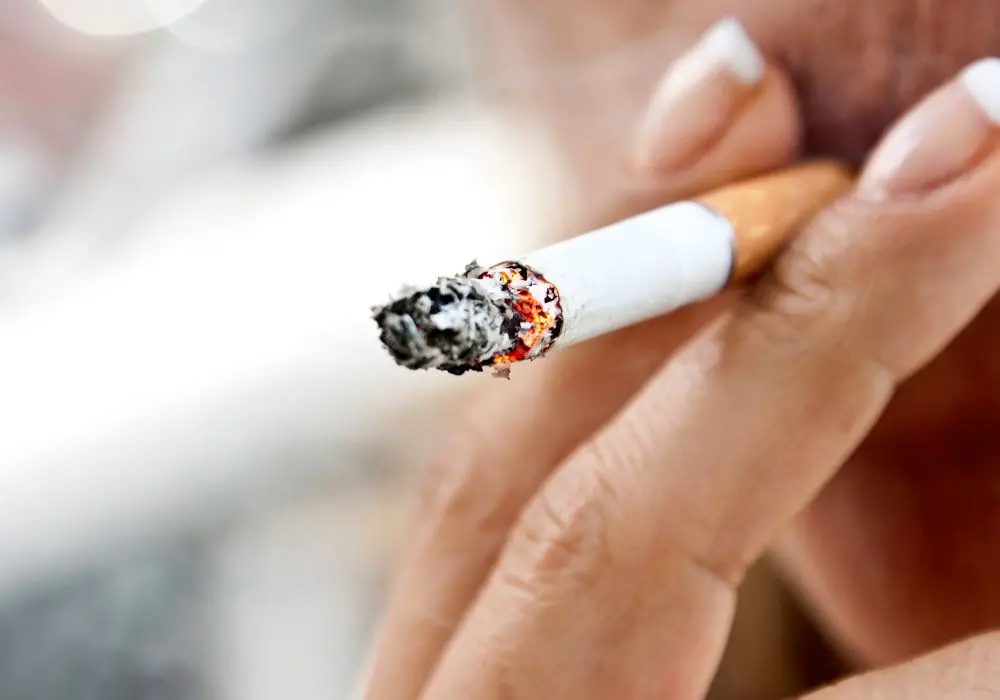
Dental implants act as artificial tooth roots to support teeth crowns or bridges. They are inserted into the jawbone, where the bone grows into direct contact with the implant surface through osseointegration.
Smoking negatively affects implants:
- The over 4,000 toxins in tobacco smoke restrict blood flow to the gums and bone tissue. This reduces delivery of nutrients and oxygen needed for healing.
- Nicotine limits the attachment of new cells to implant surfaces that triggers osseointegration.
- Free radicals and carcinogens in cigarette smoke damage cell walls. This impairs the cells that develop bone matrix.
Together, these factors greatly increase the risk of implant failure in smokers. Implant success rates in smokers can be up to 50% lower compared to nonsmokers.
However, once you quit smoking, your odds of successful osseointegration and implant healing increase substantially:
- After just 48 hours smoke-free, increased oxygen in the bloodstream starts improving healing capabilities.
- Within 1-2 weeks, blood circulation to the gums and jawbone return closer to normal levels.
- After 1-2 months tobacco-free, implant success rates boost to over 95% – similar to never smokers.
So when placed properly, dental implants can survive long-term with good stability and retention in former smokers. Just be sure to follow pre- and post-op instructions closely to keep the delicate implant integration site healthy while the surrounding bone is still maturing and gaining strength during the first 6-12 months. More time smoke-free is better when considering implants. But the benefits start quickly, so don’t delay needed tooth replacement once you’ve committed to quitting smoking.
Frequently Asked Questions
How long after quitting smoking do teeth look whiter?
It can take a few weeks up to 6 months to notice teeth looking visibly whiter after quitting smoking. Surface stains on teeth will gradually wear off over time, helped by brushing and mild abrasives like whitening toothpaste or baking soda. This reveals more of the natural tooth color underneath. For more dramatic brightening of deep intrinsic stains, professional whitening or restorations are needed.
Do receding gums grow back after quitting smoking?
Unfortunately, receding gums don’t grow back or reattach on their own once they have shrunk away from the teeth. The gum tissue itself recedes and won’t fill back in the gap. Quitting smoking allows any remaining gum tissue to reattach more firmly and resist additional recession. Proper brushing technique is important to avoid forcing gums down further. Managing gum disease through excellent oral care helps maintain the gums you still have. In some cases, grafting procedures may help cover exposed roots.
Can I get dental implants if I quit smoking a month ago?
Yes, you can get successful dental implants after quitting smoking as little as 1 month ago. Your implant healing prognosis improves significantly within just weeks of stopping cigarette use as blood flow and oxygenation increase. The longer you have been tobacco-free the better for ideal implant integration. But don’t delay needed tooth replacement once you’ve committed to quitting smoking. Just be diligent with oral hygiene and follow all implant aftercare instructions for best results.
How can I remove tobacco stains from my teeth?
Tobacco stains on natural tooth enamel don’t go away on their own. Brushing with whitening toothpaste or baking soda can lighten stains slightly over time. Otherwise, professional teeth whitening, dental bonding, porcelain veneers, or dental crowns are likely needed to improve the appearance of stained teeth and enhance your smile. These cosmetic dentistry treatments performed by a dentist can make unsightly smoking stains much less noticeable.
Can smoking damage to teeth be reversed completely?
No, the damage smoking does to teeth and gums can’t be 100% reversed in most cases. Stains on natural teeth are permanent and difficult to remove fully. Bone loss from severe gum disease usually can’t be completely regrown. Tooth decay or fractures require restorations. However, quitting smoking allows significant healing and recovery that greatly improves oral health. Gum disease progression is halted and managed. Remaining teeth are better protected from additional decay and loss. The risk of further smoking-related harm is dramatically reduced. So while some effects remain, stopping smoking brings major oral health benefits.
Conclusion
Years of tobacco use can destroy teeth and gums through discoloration, gum disease progression, and accelerated tooth loss. The staining and destruction done can’t be undone completely. However, quitting smoking provides substantial oral health benefits. Gums regain strength, tooth decay risks drop, implants integrate better, and cancer risks decline.
While dental treatments are often still needed to fix existing damage, the continued progression of smoking-related oral disease slows drastically. Taking steps to quit smoking leads to much healthier teeth and gums long-term. Recovery is possible and the oral benefits of stopping tobacco use are well worth it. It’s never too late to stop smoking and let your smile benefit.


